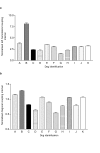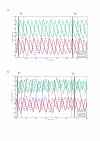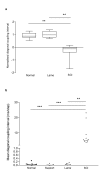Development of a universal measure of quadrupedal forelimb-hindlimb coordination using digital motion capture and computerised analysis
- PMID: 17877823
- PMCID: PMC2063503
- DOI: 10.1186/1471-2202-8-77
Development of a universal measure of quadrupedal forelimb-hindlimb coordination using digital motion capture and computerised analysis
Abstract
Background: Clinical spinal cord injury in domestic dogs provides a model population in which to test the efficacy of putative therapeutic interventions for human spinal cord injury. To achieve this potential a robust method of functional analysis is required so that statistical comparison of numerical data derived from treated and control animals can be achieved.
Results: In this study we describe the use of digital motion capture equipment combined with mathematical analysis to derive a simple quantitative parameter - 'the mean diagonal coupling interval' - to describe coordination between forelimb and hindlimb movement. In normal dogs this parameter is independent of size, conformation, speed of walking or gait pattern. We show here that mean diagonal coupling interval is highly sensitive to alterations in forelimb-hindlimb coordination in dogs that have suffered spinal cord injury, and can be accurately quantified, but is unaffected by orthopaedic perturbations of gait.
Conclusion: Mean diagonal coupling interval is an easily derived, highly robust measurement that provides an ideal method to compare the functional effect of therapeutic interventions after spinal cord injury in quadrupeds.
Figures






References
-
- Kleitman N. Keeping promises: translating basic research into new spinal cord injury therapies. J Spinal Cord Med. 2004;27:311–8. - PubMed
-
- Huang H, Chen L, Wang H, Xiu B, Li B, Wang R, Zhang J, Zhang F, Gu Z, Li Y, Song Y, Hao W, Pang S, Sun J. Influence of patients' age on functional recovery after transplantation of olfactory ensheathing cells into injured spinal cord injury. Chin Med J (Engl) 2003;116:1488–1491. - PubMed
Publication types
MeSH terms
LinkOut - more resources
Full Text Sources

